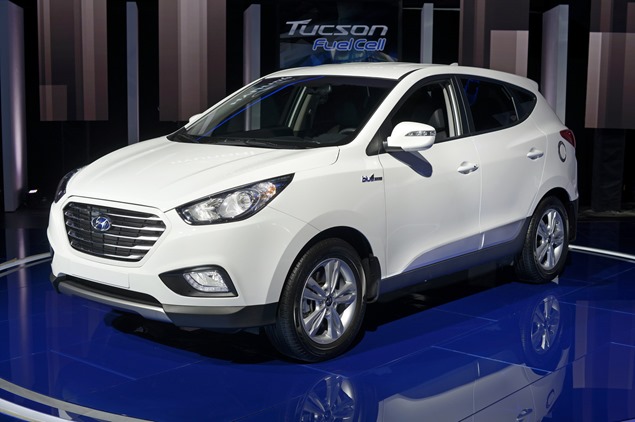
Billed as the world's "first mass-produced fuel cell vehicle", the production 2015 Hyundai Tucson Fuel-Cell was revealed moments ago at the Los Angeles Auto Show.
Hyundai said the hydrogen-powered electric model will initially be offered as a lease to customers in the Los Angeles/Orange County region in spring of 2014 for $499 (€371) per month for a 36-month term, with a$2,999 (€2,200) down payment.
The program includes unlimited free hydrogen refueling and the same "At Your Service Valet Maintenance" offered for Equus customers in which, whenever the car requires service, a Hyundai dealer will come pick up the vehicle and provide a loaner, then return their car after service to their home or business, at no charge.
So, what powers the Tucson Fuel-Cell? The system includes an electric motor that turns the wheels, and a fuel-cell system that effectively replaces the battery pack used in an electric vehicle by generating electricity from hydrogen through an electrochemical process, which Hyundai describes thusly:
1 Hydrogen enters the anode, air (oxygen) enters the cathode
2 Catalyst splits the hydrogen electrons and protons
3 Electrolyte conducts the positively-charged ions while blocking the electrons
4 Electrons are used to create an external circuit, generating electricity
5 Catalyst combines the hydrogen ions and electrons with oxygen to create water and heat energy
6 A single fuel cell produces approximately one volt; fuel cells are “stacked” to meet voltage requirements
According to the automaker, with a full tank of hydrogen, the fuel-cell Tucson has a driving range of up to 300 miles (a little over 480 kilometers) with zero greenhouse-gas emissions, as the only by-product of the process is water vapor. The tank can be filled in under 10 minutes, which Hyundai says is roughly the same time as a gasoline car.
Hyundai adds that there are "minimal cold-weather effects compared with battery electric vehicles" and that it has "successfully completed extensive crash, fire and leak testing".





